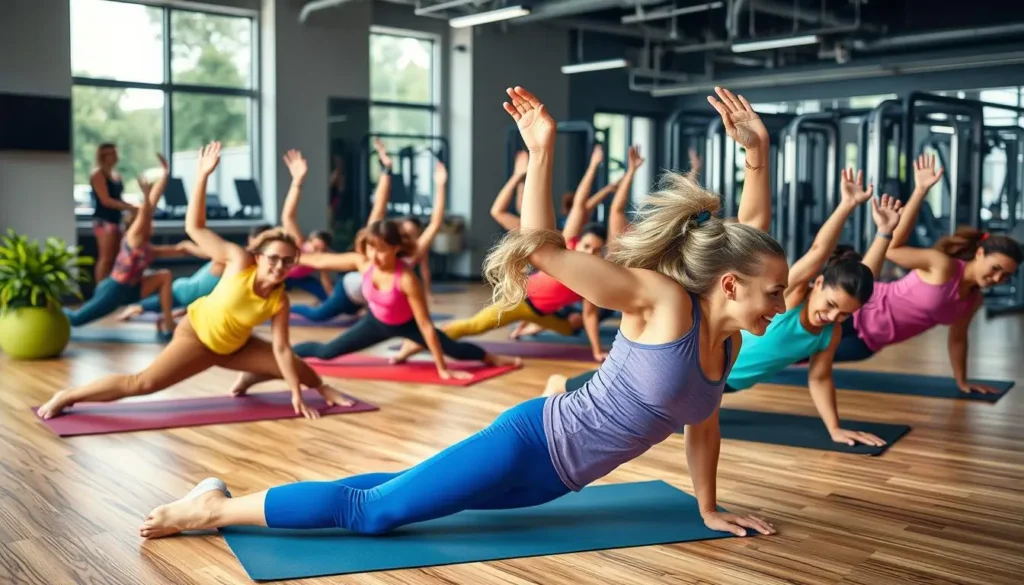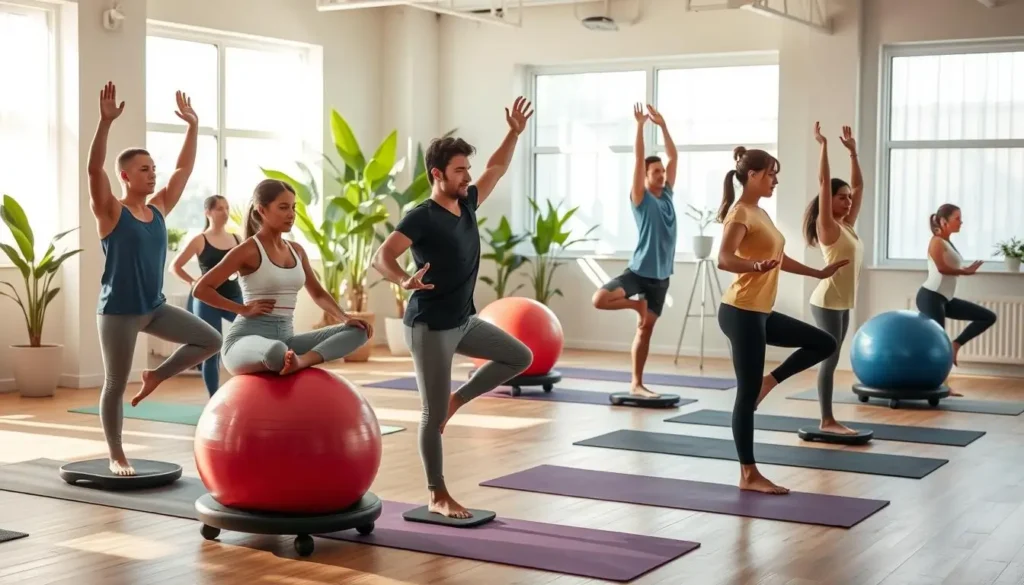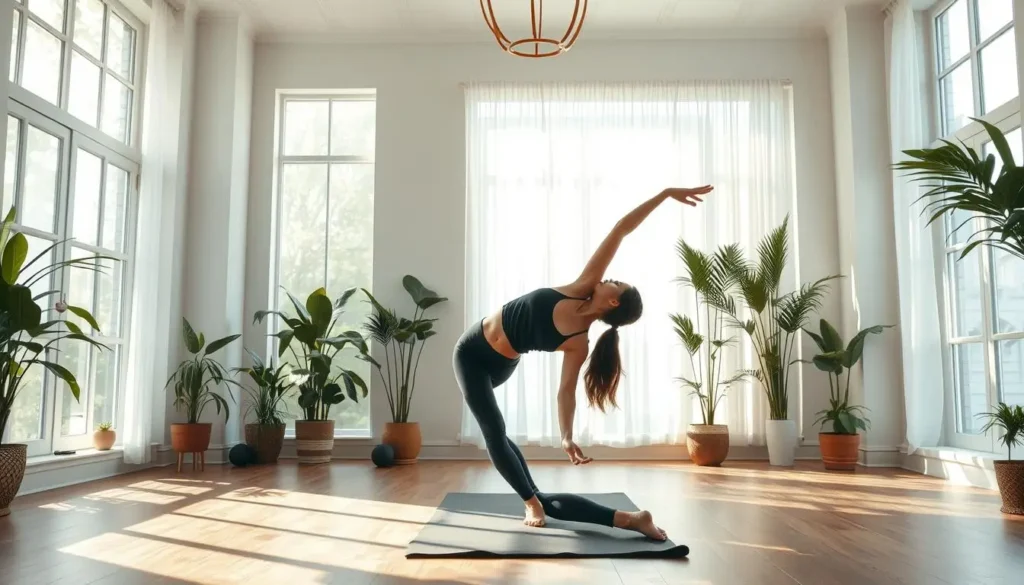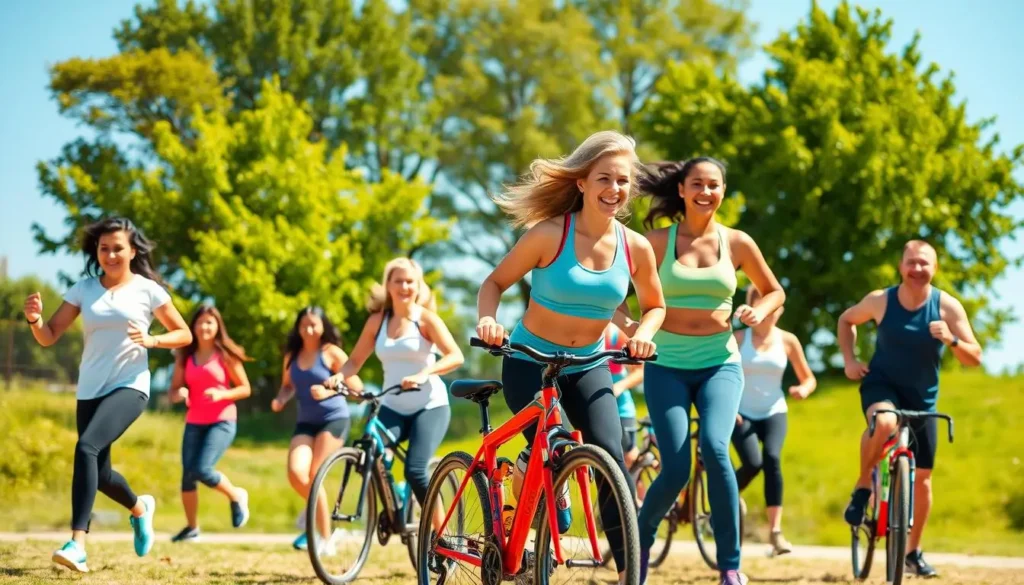Exercise Routines : Do you feel tired and unhappy with your body? A good exercise routine can make you feel better. But, starting can be hard. We’ll show you how to find the best exercise plan for you.

Exercise Routines, This guide will teach you about a balanced fitness routine. You’ll learn how to make a plan that changes your body and mind. We’ll cover aerobic exercises, strength training, and more to help you reach your fitness goals.
Table of Contents
Key Takeaways for Exercise Routines
- A good fitness routine has aerobic, strength, core, balance, and flexibility exercises.
- Walking fast can burn 500 calories an hour and help you lose a pound for every seven hours.
- Doing squats, lunges, and push-ups works many muscles and speeds up your metabolism.
- Getting help from a fitness expert, especially if you’re new, can prevent injuries and teach you how to do exercises right.
- Exercising often can lower the risk of serious diseases and make you more balanced and coordinated.
The Importance of a Well-Rounded Fitness Routine
Getting fit means doing a little bit of everything. You need cardio exercises for your heart and strength training for your muscles. This mix helps you stay healthy in many ways.
Aerobic Fitness: Revving Up Your Cardiovascular Health
Aerobic exercises are key to a healthy life. The Department of Health says most adults should do 150 minutes of moderate activity weekly. Or, do 75 minutes of hard activity weekly, or mix both.
For losing weight, you need more. Aim for 300 minutes of aerobic activity weekly. Walking, jogging, swimming, and cycling are great choices that fit your level.
Strength Training: Building Muscle and Boosting Metabolism
Strength training is also vital. It builds muscle, which helps your metabolism. This makes your body healthier.
The article says to work all major muscles twice a week for best results. Try weightlifting, bodyweight exercises, or resistance bands for strength training.
By mixing cardio exercises for heart health and strength training for muscles, you get a full fitness plan.
“Consistency and variety are key to achieving and maintaining optimal fitness.”
Core Exercises: The Foundation of Functional Fitness
Having a strong core is key for keeping your body stable and balanced. The core muscles help support your spine. They also make moving easier, whether it’s for daily tasks or tough workouts.
Doing exercises like planks, bridges, and crunches can help a lot. They make it easier to balance and stand up straight. You’ll also find it simpler to do everyday things.
Core exercises are often overlooked in fitness routines, despite their importance as an integral part of a well-rounded fitness program. But, a strong core is the base for being fit. It lets you move with more control and power.
Functional core exercises like planks, dead bugs, and bird dogs work many muscles at once. They boost strength, stability, and sports performance. These exercises also help your shoulders, glutes, and other muscles. This makes your body work better and lowers injury risk.
Mixing traditional and functional core exercises in your workout is best for fitness. Focusing on core strength lets you do more with less effort. This makes daily tasks and hard workouts easier.

“A strong core is the foundation for a well-rounded fitness routine, allowing you to move with greater ease and efficiency in all aspects of life.”
Balance Training: Stability for Everyday Life
Keeping your balance is key to staying active and independent, especially as you get older. Doing balance exercises like standing on one leg can make you more stable. This can lower the chance of falling.
Studies show that balance exercises can cut down on falls by 37%. They also reduce serious injuries by 43% and broken bones by 61% in older adults. These exercises can also boost athletes’ power and control, making them more efficient.
Yoga and Tai Chi: Ancient Practices for Modern Balance
Yoga and tai chi are ancient practices that challenge your balance. They also improve flexibility, muscle strength, and focus. These exercises can make your core muscles stronger, making you more stable.
Adding simple balance exercises to your daily routine can improve coordination and balance. Using a BOSU can make balance training more effective. It helps improve posture and core stability, making everyday movements more efficient.
Balance exercises are good for everyone, from seniors to athletes. Seniors use them to prevent falls, while athletes improve their performance. These exercises keep the body active and prevent injuries in seniors.
For kids, balance exercises can be fun. They can learn math or vocabulary while improving their balance. Athletes benefit from these exercises by gaining stability and coordination, essential for sports.
Good balance makes everyday tasks easier, like walking on stairs or carrying heavy items. It improves health and fitness, preventing injuries and falls, especially in older adults and those with Parkinson’s disease. Balance exercises are for everyone, regardless of age or fitness level.

“Incorporating balance exercises into your workout routine can be a game-changer for your overall fitness and mobility.”
Flexibility and Stretching: Unlocking Your Full Range of Motion
Keeping your body flexible is key to a good fitness plan. Stretching regularly helps you move better, lowers injury risk, and boosts your performance.
Stretching makes your joints and muscles more flexible. Studies show it can cut injury risk by up to 30% by making muscles and tendons more elastic. Also, being flexible can lower your chance of poor posture and chronic pain by 25%.
For those who are active, being flexible can increase your range of motion by 15%. This means you can move more efficiently and perform better. Stretching also improves joint health by 20% by helping synovial fluid move. Plus, it makes your muscles work better during workouts, targeting specific areas more effectively.
Adding flexibility exercises to your routine can boost your performance by 25% in various activities. Stretching also cuts muscle soreness after working out by up to 15%. This helps you recover faster and train more consistently.
Keeping up with stretching can also slow down age-related issues like joint stiffness and muscle loss. This keeps you healthy for longer.
Dynamic stretching, like movements that get faster and longer, boosts muscle performance. Static stretching, holding a stretch for 20-30 seconds, improves flexibility over time. Mixing static and dynamic stretches with strength training, like in yoga and Pilates, helps muscles grow longer and stronger for better flexibility.
Exercises like hip circles and shoulder rolls keep joints healthy and mobile. Strength training that moves joints fully can also boost mobility by strengthening muscles that support joints. Using foam rollers or massage balls for myofascial release can also loosen tight fascia, improving flexibility and mobility.
Pilates is great for building core strength, stability, and flexibility. It focuses on controlled movements and proper alignment to enhance flexibility, especially with an AeroPilates. Pilates emphasizes concentration, precision, and control to engage the mind, target specific muscles and joints, and prevent injuries while increasing range of motion.
Dynamic stretching in Pilates moves muscles and joints fully, improving flexibility and preparing the body for activity. Pilates also engages deep muscles like the transversus abdominis and pelvic floor to stabilize the spine and pelvis, enhancing flexibility. Using a reformer machine like the Elina Cadillac Reformer in Pilates can target different muscle groups for better flexibility.
By making stretching a regular part of your fitness routine, you can move better, perform better, and avoid injuries. This leads to a healthier, more active life.

Cardio Workouts: Get Your Heart Pumping
Cardio exercises are great for your heart and endurance. You can choose from easy activities or intense HIIT. Adding different cardio workouts to your routine helps you meet your health goals.
Low-Intensity Cardio: Steady and Sustainable
Low-intensity cardio like brisk walking or cycling is easy to do daily. It offers lasting benefits. Experts say to do aerobic exercise for 30 minutes, five days a week. This helps your heart get stronger and boosts your overall health.
High-Intensity Cardio: Push Your Limits
HIIT is about short, intense workouts followed by rest. It helps you reach your limits and work out efficiently. People should do moderate exercise two to three times a week for 30 minutes. They should also do a longer activity for at least an hour once a week.
Adding both low and high-intensity cardio to your routine is good. It lets you choose what fits your level and likes. This way, you get the best of both worlds for your heart and fitness.

“Consistency is key when it comes to cardio workouts. Whether you prefer a leisurely stroll or a heart-pounding HIIT session, make it a habit to get your heart pumping regularly.”
Strength Training for Longevity
Strength training helps keep muscles, bones, and body function strong as we get older. It builds lean muscle, keeping us mobile and independent. You can use your body, bands, machines, or weights to get stronger.
Bodyweight Exercises: The Anywhere, Anytime Option
Bodyweight exercises like pushups and squats are easy to do anywhere. They fight muscle loss that starts in our 40s. By our 80s, we can lose half our muscle mass without them.
Weight Machines and Free Weights: Sculpting Your Physique
Weight machines and free weights target specific muscles better than bodyweight exercises. Mixing these in your routine keeps you healthy and independent. Studies show they also lower body inflammation, which is good for health.
Strength training offers many benefits for living longer. A big study found it lowers disease risk by 10-17%. It also boosts hand strength, showing overall health benefits.
Adding strength training to your life keeps you strong and healthy. It reduces disease risk and supports a long, independent life.
“Regular physical activity significantly lowers the risk of all-cause mortality by up to 35%.”
Finding the Right exercise routines for Your Goals
Getting fit means having a plan that’s just for you. You might want to get your heart rate up, get stronger, or move better. It’s important to find a workout that fits your goals.
Many gyms offer free sessions with a trainer. This is great for beginners or those with new goals.
A good workout mix is key. You should do cardio, strength training, and exercises for flexibility. Each type helps in different ways, depending on what you want to achieve.
Maclin says to do flexibility exercises five times a week. This helps with losing weight, building muscle, or staying fit.
Building strength takes time and effort. You need to do strength training two to four times a week. Use your body, bands, or weights to get stronger.
It’s important to see how you’re doing. Track your progress for two to four weeks to see if your plan is working.
Your goals might change over time. Adjust your workout to fit your body, health, and goals.
Finding the right workout is a journey. Work with a trainer or use online tools to make a plan that’s just for you. With the right mix of activities and a flexible plan, you can get the most out of exercise.
Exercising for Every Age: It’s Never Too Late to Start
Exercise is key at every stage of life, from kids to seniors. Exercise at any age boosts both body and mind, helping us age well. Even if you’ve never been active, starting now is a great idea.
Seniors can try easy activities like walking, swimming, or light strength training. These help keep the heart healthy, muscles strong, and balance good. People over 50 should mix endurance, balance, strength, and flexibility exercises.
Studies show our bodies can adapt at any age. Even in their 70s and 80s, people can build muscle and get fitter with weight training. Staying active at any age leads to a better life.
The National Institute on Aging has free tools like a book and DVD for seniors. These help seniors add exercise to their daily life, making it easier to start a healthier future.
“Anyone at any age has the potential to improve skeletal-muscle health and quality of life with progressive weight training.”
By choosing exercise at any age, people can enjoy many benefits. They stay independent, full of life, and well into their later years.
Conclusion
Creating a good exercise routine is key. It should cover aerobic activity, strength training, and more. This way, you get many physical and mental benefits.
Make your exercise plan fit your goals and likes. This makes fitness fun and helps your health and well-being. Adding different exercises helps you reach your goals and stay healthy for a long time.
Using a holistic approach to fitness lets you enjoy many benefits. You’ll see better heart health and stronger muscles. Plus, you’ll get better balance, flexibility, and mental health.
Make exercise a regular part of your life. This is an investment in your long-term health. Find exercises you like, so you stay excited about your fitness journey.
By focusing on your health through exercise, you can change your body and mind. Enjoy the journey and celebrate your successes. A balanced holistic fitness approach brings many benefits to your life.
Stay dedicated to your well-being. This builds a strong base of long-term health for the future.
FAQ
What are the key elements of a well-rounded fitness routine?
How does aerobic exercise benefit overall health?
What are the benefits of strength training?
Why are core exercises important?
How can balance training benefit your overall fitness?
What are the benefits of flexibility and stretching?
What are the different types of cardio workouts, and how do they benefit health?
How can strength training support long-term health and independence?
How can you create a personalized exercise routine that meets your specific goals?
Why is it important to stay physically active throughout your lifetime?
Healthy Weight Loss Diet 2026: 7 Proven Strategies That Actually Work for Men and Women
Are you tired of yo-yo dieting and looking for a healthy weight loss diet that delivers lasting results? You’re not alone. In 2026, millions of people are searching for sustainable approaches to weight management that don’t involve extreme restrictions or impossible-to-maintain meal plans.
The truth is, most commercial diets fail because they focus on quick fixes rather than long-term lifestyle changes. This comprehensive guide will show you exactly how to create a healthy weight loss diet that works for both men and women, backed by the latest nutritional science and real-world success stories.
Whether you’re looking to lose 10 pounds or 100, the strategies outlined in this article will help you achieve your goals while maintaining your health, energy, and sanity. Let’s dive into the proven methods that are transforming lives in 2026.
Source Links
- 7 Most Effective Exercises
- 5 steps to start a fitness program
- 5 basics of a well-rounded fitness routine
- What Is A Well-Rounded Workout?
- The Importance of a Well-Rounded Workout | Kelsey-Seybold Clinic
- Why your core muscles matter
- Functional Core Workout | Educate Fitness
- 5 Balance Exercises to Boost Stability
- Balance exercises: 13 Moves with Instructions
- Unlocking your full potential: Importance of Stretching for enhanced Flexibility and Mobility
- The Ultimate Guide to Improving Flexibility and Understanding Mobility – Central Ohio Spine and Joint
- Pilates For Flexibility: Unlocking Suppleness And Range Of Motion With
- 3 Kinds of Exercise That Boost Heart Health
- The ‘best’ cardio workout for a healthy heart | Heart | UT Southwestern Medical Center
- Strength Training for Longevity: How Just 30-60 Minutes per Week Can Lower Death Risk by Over 10% – Unlocking Insights – Explore Our Articles
- Best Exercise Routines for Longevity: Live Longer and Healthier – Essential Sports & Spine Solutions
- How Much Exercise Do You Need to Improve Longevity? (Hint: It’s Not As Much As You Think)
- How to create a workout plan for your fitness goals
- Living Proof That It’s Never Too Late to Start Exercising
- I’m a Fitness Trainer Who Didn’t Begin Working Out Until Later in Life. Here’s Why You’re Never Too Old To Start
- You’re Never Too Old
- 7 great reasons why exercise matters
- Benefits of Exercise: MedlinePlus
- Consistent Morning Exercise May Be Beneficial For Individuals with Obesity




